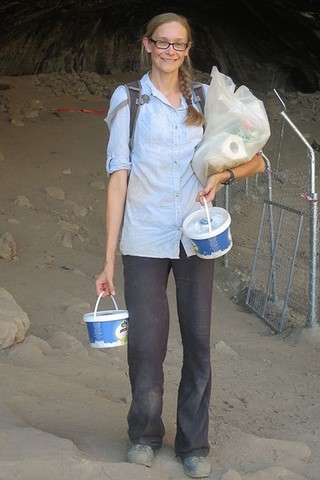New discoveries at the Neanderthal "flower cemetery."
New skeleton find at the Shanidar Cave in Irak

Decades ago, the discovery of flower-pollen around the skeletal remains of Neanderthals in the Shanidar Cave in Iraqi Kurdistan gave rise to an enduring controversy around the question of whether the Neanderthals might have grieved for their dead and buried them with a display of respect. A new find of an almost fully preserved Neanderthal skeleton in that same cave makes it possible to draw new conclusions.
As announced by the team of researchers around Dr. Emma Pomeroy (picture) of Cambridge University in the scientific journal "Antiquity", the find constitutes « the first articulated skeleton of a Neanderthal which has been found in the last twenty years and which could be retrieved – and this, moreover, in one of the archaeologically most significant sites. This new find offers an unparalleled opportunity to study the 'burial practices' of the lost species, using the newest available technologies."
The Shanidar-Cave was excavated for the first time in the 1950s, when archaeologist Ralph Solecki discovered at the site the remains of ten Neanderthal individuals, men, women and children. In the direct vicinity of some of these skeletons were found clumps of old pollen. For Solecki, at the time, this was evidence that Neanderthals buried their dead and went through burial rites which included the use of flowers. Already then, these « flower-burials » stimulated public imagination and brought about a new appraisal of a hominid species which – before the finds at the Shanidar Cave – had been considered to be « dumb and beastly. »
These finds then sparked a controversy lasting decades about whether the evidence from this extraordinary site really indicated death rituals and burials of any kind, and if the Neanderthal could really have been capable of such cultural refinements.
More than 50 years later, the scientists lead by Pomeroy have now reopened the old Solecki excavations in order to retrieve samples of sediments and at this occasion, they came upon the skull and torso bones of an additional Neanderthal yet undiscovered, which they designated as « Shanidar Z. » As a result, the scientists reevaluated the earlier finds with the help of the new means and methods which are available today.
In 2016, there emerged in one of the deepest parts of the trench a rib bone, followed by a lumbar vertebra and a bone of a clenched fist. Meters of sediments needed to be carefully excavated before the team was able to retrieve the skeleton.

The first analyses suggest that the skeleton is more than 70,000 years old. Whereas the gender is still to be determined, the teeth seem to indicate a middle-aged or older adult.
Sediment samples from the direct environment of the find have been and are still being investigated for indications about climatic conditions from shells, bone fragments of old mouse species, or snails, as well as for traces of pollen and charcoal , with the help of which the researchers hop to gain insights about Neanderthal activities such as food preparation, or maybe even draw conclusions about another « flower-burial. »
Together with the earlier finds, among which the famous « flower-tomb, » the Shanidar-Cave represents a « unique collection » of Neanderthal skeletons, according to the scientists: « They raise the question whether the Neanderthals kept returning to the same place in the cave in order to bury their dead there." And indeed, the researchers found near the head of Shanidar Z a rock of a distinctive shape, which might have been used as some sort of tombstone, or place-marker of a « cemetery. » However, it is difficult to evaluate intervals between the individual burials.
“This new excavation suggests that some of these dead were deposited in a canal in the cave floor which had already before been created by water, but then later had been dug out deeper on purpose, » explains Professor Graeme Barker from Cambridge’s McDonald Institute of Archaeology. “There are therefore strong indications that the burial of Shanidar Z was deliberate. »
On the basis of several particularly well preserved bones of Skeleton Z, the scientists are now hoping to be able to retrieve DNA probes from the ancient Neanderthals which inhabited this hot and dry region, where it is highly likely that « crossings » occurred when modern humans arrived there from Afrika.
Pomeroy adds in conclusion : « These last years we have increasingly seen signs that the Neanderthals were far more sophisticated as had been assumed up to now. From cave markings, to the use of decorative shells and of the talons of birds of prey. If the Neanderthals used the Shanidar-Cave as a memorial place for repeated, ritual burials of their dead, this would indicate a cultural complexity of the highest order. »
From the site Grenzwissenschaft-aktuell
Translated from the German by Anne-Marie de Grazia

